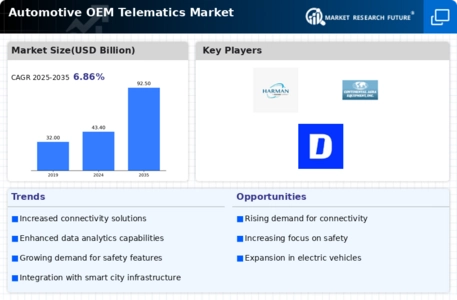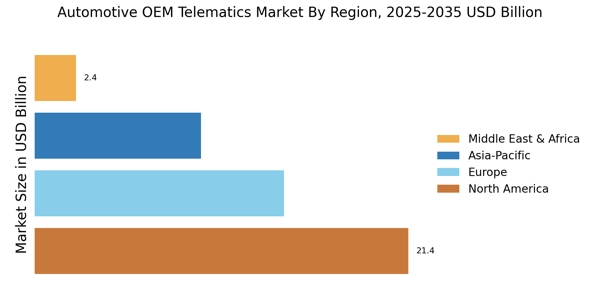Growth of Electric and Autonomous Vehicles
The Automotive OEM Telematics Market is poised for growth due to the increasing prevalence of electric and autonomous vehicles. As manufacturers pivot towards sustainable mobility solutions, the demand for telematics systems that support electric vehicle (EV) functionalities is on the rise. Data indicates that the EV market is expected to witness a substantial increase, with projections estimating that electric vehicles could account for over 30% of total vehicle sales by 2030. This shift necessitates advanced telematics solutions that can monitor battery health, optimize charging, and provide real-time data to users. Furthermore, the integration of telematics in autonomous vehicles is critical for navigation, safety, and communication with other vehicles. Thus, the Automotive OEM Telematics Market is likely to benefit from the convergence of these trends, as manufacturers seek to enhance the capabilities of their electric and autonomous offerings.
Increased Connectivity and IoT Integration
The Automotive OEM Telematics Market is witnessing a transformation driven by increased connectivity and the integration of Internet of Things (IoT) technologies. The proliferation of connected devices has created a demand for telematics systems that can seamlessly communicate with various platforms. Data suggests that the number of connected vehicles is expected to reach over 500 million by 2025, highlighting the need for robust telematics solutions. This connectivity enables real-time data exchange, enhancing vehicle performance, maintenance, and user experience. Furthermore, the integration of IoT allows for advanced analytics, enabling manufacturers to gather insights into vehicle usage patterns and consumer behavior. Consequently, the Automotive OEM Telematics Market is likely to expand as manufacturers leverage connectivity to offer innovative services and improve overall vehicle functionality.
Regulatory Compliance and Data Privacy Concerns
The Automotive OEM Telematics Market is significantly influenced by regulatory compliance and data privacy concerns. As governments worldwide implement stricter regulations regarding data protection and vehicle safety, automotive manufacturers are compelled to adopt telematics solutions that ensure compliance. Recent legislation has emphasized the importance of safeguarding consumer data, which has led to an increased focus on secure telematics systems. This shift is evident in the growing investment in technologies that enhance data encryption and user privacy. Moreover, compliance with regulations not only mitigates legal risks but also enhances consumer trust in telematics services. As a result, the Automotive OEM Telematics Market is likely to see a rise in demand for solutions that prioritize regulatory adherence while delivering innovative telematics functionalities.
Consumer Demand for Enhanced In-Vehicle Experience
The Automotive OEM Telematics Market is increasingly shaped by consumer demand for an enhanced in-vehicle experience. As technology evolves, consumers expect more from their vehicles, including seamless connectivity, entertainment options, and personalized services. Recent surveys indicate that a significant percentage of consumers prioritize in-vehicle technology when purchasing a vehicle, driving manufacturers to invest in advanced telematics solutions. This trend is reflected in the growing market for infotainment systems and connected services, which are projected to grow at a rapid pace. By integrating telematics with user-friendly interfaces, manufacturers can provide a more engaging and interactive driving experience. Therefore, the Automotive OEM Telematics Market is likely to thrive as companies focus on meeting consumer expectations for innovative in-vehicle technologies.
Rising Demand for Advanced Driver Assistance Systems
The Automotive OEM Telematics Market is experiencing a notable surge in demand for advanced driver assistance systems (ADAS). This trend is largely driven by the increasing emphasis on vehicle safety and the desire to reduce road accidents. According to recent data, the market for ADAS is projected to grow significantly, with estimates suggesting a compound annual growth rate of over 10% in the coming years. As consumers become more aware of the benefits of these technologies, automotive manufacturers are integrating telematics solutions that enhance vehicle safety features. This integration not only improves the driving experience but also aligns with regulatory requirements aimed at enhancing road safety. Consequently, the Automotive OEM Telematics Market is likely to see a robust expansion as manufacturers invest in innovative telematics solutions that support ADAS functionalities.


















Leave a Comment